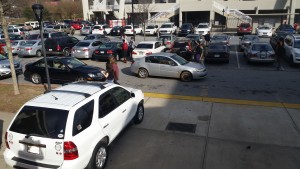
Winter is finally upon us. As the weather grows colder and the days get longer, students feel the urge to wrap up stay warm. Many feel they need to do this in their own cars. It’s around this time of year that many sophomores pass their driving tests and begin driving to school. These new drivers must vie for spaces with upperclassmen; this leads to an influx of traffic on campus.
“Ever since I got my license back in December, I’ve been driving to school every morning and then back home in the afternoon,” sophomore Grace Hodgson said. “A lot of my friends haven’t turned 16 yet, or ended up getting their permit late; so, I only know of around 10 kids who drive themselves [in the sophomore class].”
Ten additional drivers may sound like a small number, but Grady’s parking lots were packed before sophomores began driving to school; this a creates a troublesome situation for student drivers in the morning who arrive at school between 8:15 a.m. and 8:20 a.m.
“I don’t park in the main parking lot where most students go first,” Hodgson said. “Instead, I park in the gravel lot. So, it’s usually empty when I get there and pretty easy to park in. In terms of time, I drive one of my close friends to school; so, if she’s running late, then I am too, but most of the time we get to school around 8:20.”
During the morning rush, parking and traffic can be very hectic and pose a real problem for administration. Sophomore drivers create another logistical problem.
“We try to make sure that we can accommodate all the students,” Assistant Principal Dr. David Propst said. “If they can’t park in the gravel lot, we allow them to park in the football field [parking lot]. Another problem for parking is activities like voting, which take up space in our parking lots.”
The majority of the student population rides the bus or walks to school because it is simpler and less stressful. Some students don’t drive to school because they don’t have a car, their license, or because it is too far away.
“The parking lot just isn’t that big, and it gets full quick because there aren’t a ton of spaces for the amount of people trying to park there,” junior Jack Paddock said. “Since school starts at 8:30 for everyone, everybody that drives is getting there at around the same time. So, it makes the parking lots pretty crowded.”
The path to getting a license is long and arduous. The DMV (Department of Motor Vehicles) is a nightmare, and the driving test itself is difficult. All of this combined, with a lack of time, makes it harder for some students to get their licenses.
Other than the struggle of the DMV, it is extremely costly for students to start driving. Between paying insurance which is higher for teens, buying gas, and owning a car, the price to drive is very high for young drivers.
“I would think that most people would want to drive to school. They might not have an available car or their license, which is why most people don’t,” Paddock said. “Some of my friends put off getting their permit, so they can’t get their license until probably their senior year.”
According to the U.S. Department of Transportation, over the last few years fewer teenagers have been getting their licenses. In 1983, about 72 percent of teenagers from ages 16 to 19 in the U.S. had drivers’ licenses, but by 2011, that number had fallen 51 percent.
Even though nationally, the number of teens getting licenses has declined, the number of students driving at Grady has remained relatively the same over the last decade, Dr. Propst said. Despite second semester beginning and seasonal changes, administration claims that the amount of students driving to school remains constant.
“Other people don’t drive because they have failed the test, they’re too lazy, too busy, or just simply don’t want to drive.” Hodgson said. “I have one friend who’s birthday is in July and she failed the test the first time she took it, and she was so scared that she’d fail it twice that she didn’t go back until November to try again.”







